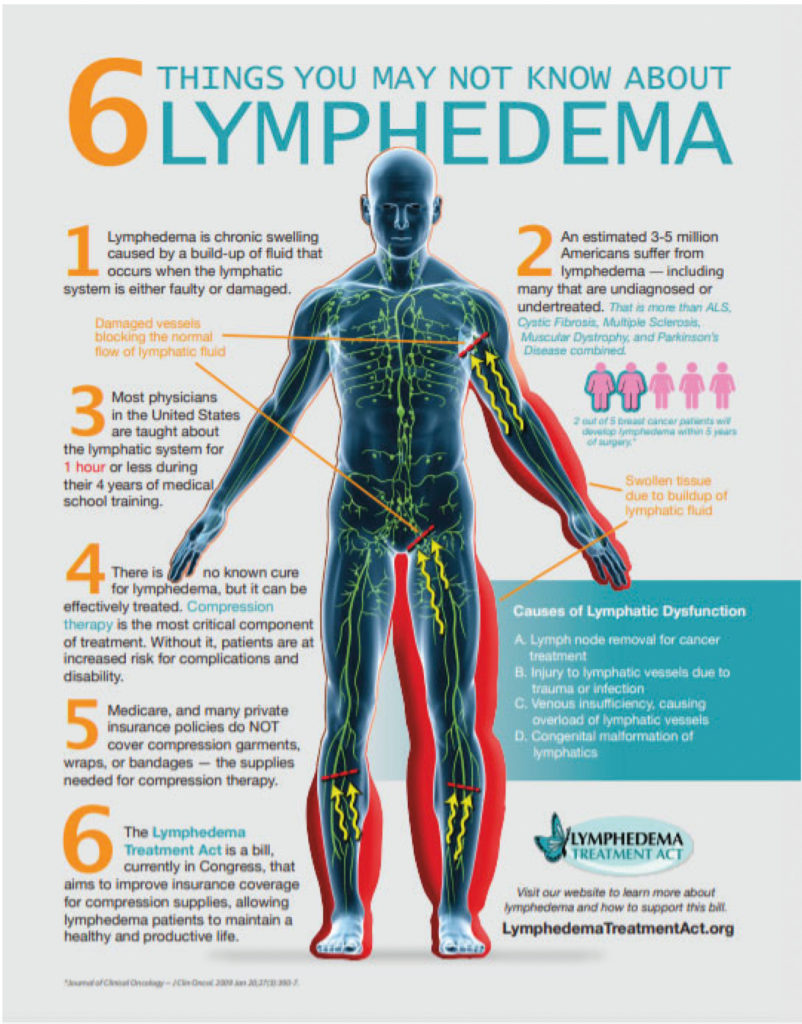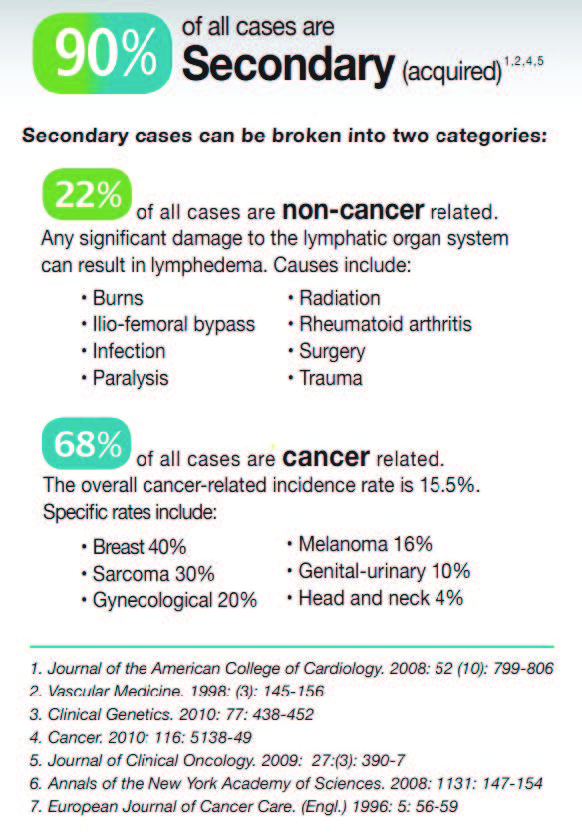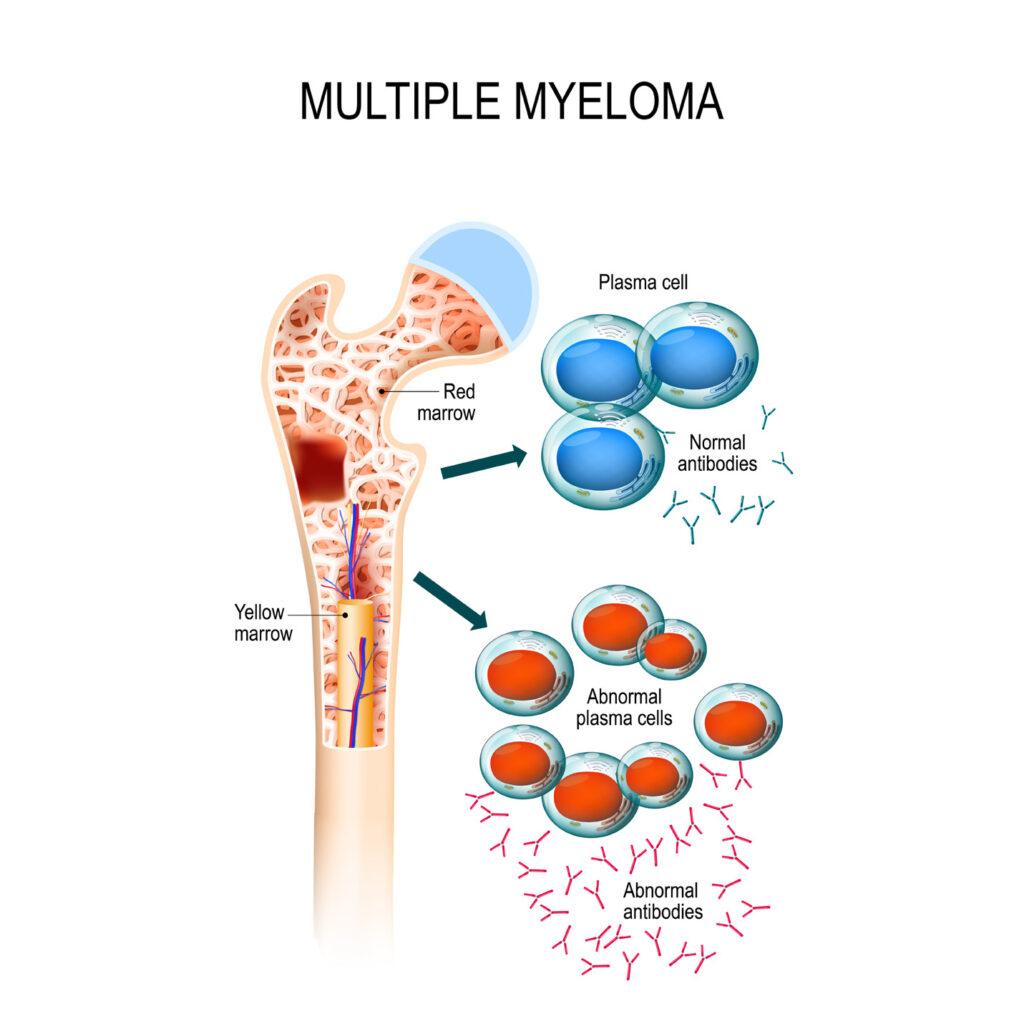March is Lymphedema Awareness Month
Lymphedema is a chronic condition that often manifests as an abnormal buildup of fluid, most commonly in the arms or legs. This swelling may be present at birth or develop without a known reason. Lymphedema can also develop as a result of another condition or treatment that damages the lymph nodes or lymph vessels, such as cancer treatment. Initially reversible, lymphedema typically progresses to irreversible, restricting range of motion and limiting activities of daily living. One of the most common causes of lymphedema occurs when lymph nodes from the underarm, called axillary lymph nodes, are damaged or removed during a mastectomy or lumpectomy for the treatment of breast cancer.

We want to help your patients dealing with chronic lymphedema whether it is related to a cancer diagnosis, a defect in the lymphatic system, or related to chronic venous insufficiency. We employ 3 certified lymphedema therapists with 135 hours of specific training in lymphedema treatment. Patients affected by lymphedema have a much better outcome if treated early in the lymphedema disease process. Refer to us sooner rather than later. What does lymphedema treatment consist of? Complete Decongestive Therapy (CDT) is the gold standard for lymphedema treatment. It consists of 4 main components.
1) Compression therapy
2) Manual lymphatic drainage
3) Decongestive exercises
4) Instruction in proper skin and nail care
Lymphedema Surveillance Programs

Let us help you monitor your patients for early signs and symptoms of lymphedema. Breast cancer survivors, head and neck cancer survivors, and melanoma survivors are frequently at risk for developing lymphedema if the survivor has had lymph nodes removed or radiated. At Ribbons Physical Therapy, we follow NCCN Version 1.2022 Survivorship guidelines where we take base line measurements of the at risk area pre-op/pre-radiation. This allows us to note small changes in the area that are many times not visually noted. Comparing previous measurements as well as monitoring the consistency of the tissue in the at risk area allows for early detection of lymphedema. These patients are followed one month after surgery/radiation and every 3 months for a year, or more frequently if indicated. Initiating treatment early can mean the difference of utilizing a compression garment all the time versus utilizing a compression garment on an as needed basis. Only having to use a compression garment on an as needed basis allows the patient to have a higher quality of life.

Ribbons PT Expands Care to Include Pelvic Health for Both Women & Men
This quarter the American Cancer Society recognizes several cancers that create deficits in which Ribbons PT can address. Our pelvic health program offers solutions to deficits caused by cervical, anal, and colon cancers.
Patients Our Pelvic Health Program Serves:
Patients with any history of cancer or lymphedema diagnoses who also have pelvic health concerns. Our program is NOT exclusive to gynecological or pelvic region cancer diagnosis.
Common Cancer diagnoses that can cause pelvic floor dysfunction:
- Cancer of female reproductive organs
- Colorectal cancer
- Breast cancer due to hormonal therapy
- Prostate cancer
Common concerns related to pelvic cancers:
- Radiation-related adhesions
- Urinary incontinence
- Associated urinary or fecal urgency
- Chronic pelvic pain, enteritis, proctitis, cystitis, tenesmus
- Sexual dysfunction, dyspareunia
What causes pelvic floor problems in people with abdominal or pelvic cancers?
- Scar tissue that forms after surgery for cancer.
- Surgery can cause tissues or muscles to shift or move.
- Radiation can cause scar tissue, hardening, or shrinking of muscles.
- In some cases, the tumor itself can be affecting the muscles.
What treatments are used in pelvic floor therapy?
- Massage of tight muscles
- Exercises to strengthen your core and pelvic floor muscles, Postural stability
- Recommend dietary changes
- Relaxation and deep breathing
- Maintain continence
Ribbons PT Adds Staff to Meet Demand for Certified Lymphedema Treatment

Ribbons PT welcomes Bethany Clontz, PT, DPT, CLT-ALM to our family. Bethany is a practitioner that truly has a passion for helping people. Her 18 year career started as a volunteer in high school which drove her to pursue her initial starting point as a Physical Therapist Assistant before completing her DPT degree. She received her Certified Lymphedema Therapist credentials in 2021, combining her experience and knowledge with a true need throughout our area. Bethany is now in the process of completing her certification in pelvic health for both women and men. A mother of two, her free time consists of children’s soccer, basketball, gymnastics and being active within Bible Baptist Church in Kingsport. She loves reading, crafting, learning, and spending time with her family.
Welcome, Bethany! We’re so glad to have you on the team!

March is Lymphedema Awareness Month
Individuals with multiple myeloma often have long treatments and periods of immobility that contribute to decreased function and physical performance. Multiple myeloma can be treated with chemo agents that have peripheral neuropathy and cardiotoxicity as side effects. Anemia and thrombocytopenia may limit one’s ability to exercise or one may not know if it is safe to exercise with abnormal blood counts. Referral to a rehab professional can assist the individual in an individualized exercise program.
At Ribbons Physical Therapy, we can monitor lab values and adjust exercise programs appropriately on a weekly basis for each patient. Low level exercise over the course of receiving chemo can assist in decreasing cardiotoxic effects of chemotherapy. Boney metastasis is always a concern in individuals with multiple myeloma and we can instruct in proper body mechanics and safe exercises to decrease the risk of fractures. If boney metastasis is present, recent research has given specific rehabilitation guidelines to follow so that strengthening can be performed in a safe manner. Strengthening and instruction in proper movement patterns can also decrease pain related to boney metastasis. Stem cell. Transplants are a common treatment for multiple myeloma. Although Stem cell transplants are not performed in this region, individuals are receiving some chemo prior to treatment at the transplant centers and returning home after the transplants. Increasing aerobic capacity and balance training before undergoing stem cell transplants will show a functional improvement during and post-transplant. Stem cell transplant recipients also will benefit from rehab post-transplant to return to pre-transplant functionalability. Studies show that this is best achieved in a supervised exercise setting.
1. Grumeretz S; WIison. CM. Evaluating the Risk of Pathologic Fracture in Metastatic Bone Disease, Rehabil Oncol. 2021;39(3):E67-E69
2. Paul KL. Rehabilitation and exercise considerations in hematologic malignancies. Am J Phys Med Rehabil. 2 011;90(5S uppl 1):S88-S94.doi:10.1097/PHM.0b013e31820be055
3. Bergenthal N, Will A, Streckmann F, et al. Aerobic physical exercise for adult patients with haematological malignancies. Cochrane Database Syst Rev. 2014;(11):CD009075. Published 2014 Nov 11. doi:10.1002/14651858.CD009075.pub2
4. Wolin KY. Ruiz JR, Tuchman H, Lucia A . Exercise in adult and pediatric hematological cancer survivors: an intervention review. Leukemia. 2010;24(6):1113-1120. doi:10.1038/leu.2010.54
If you desire to receive this newsletter electronically, please let us know:
Email: office@ribbonspt.com




